Research Methods in Business: Abstract
VerifiedAdded on 2020/03/04
|7
|1648
|104
Report
AI Summary
This report reviews the theoretical concept of teamwork and its impact on organizational performance by analyzing four key research articles. It highlights common themes such as trust, team spirit, and the importance of rewards in enhancing employee performance. The report also discusses differences in study designs and limitations, while proposing future research directions to further explore the relationship between teamwork and organizational success.

Research methods in business: Abstract 1
Research methods in business: Abstract
Name:
University
Course:
Lecturer
Department
Date
Research methods in business: Abstract
Name:
University
Course:
Lecturer
Department
Date
Paraphrase This Document
Need a fresh take? Get an instant paraphrase of this document with our AI Paraphraser
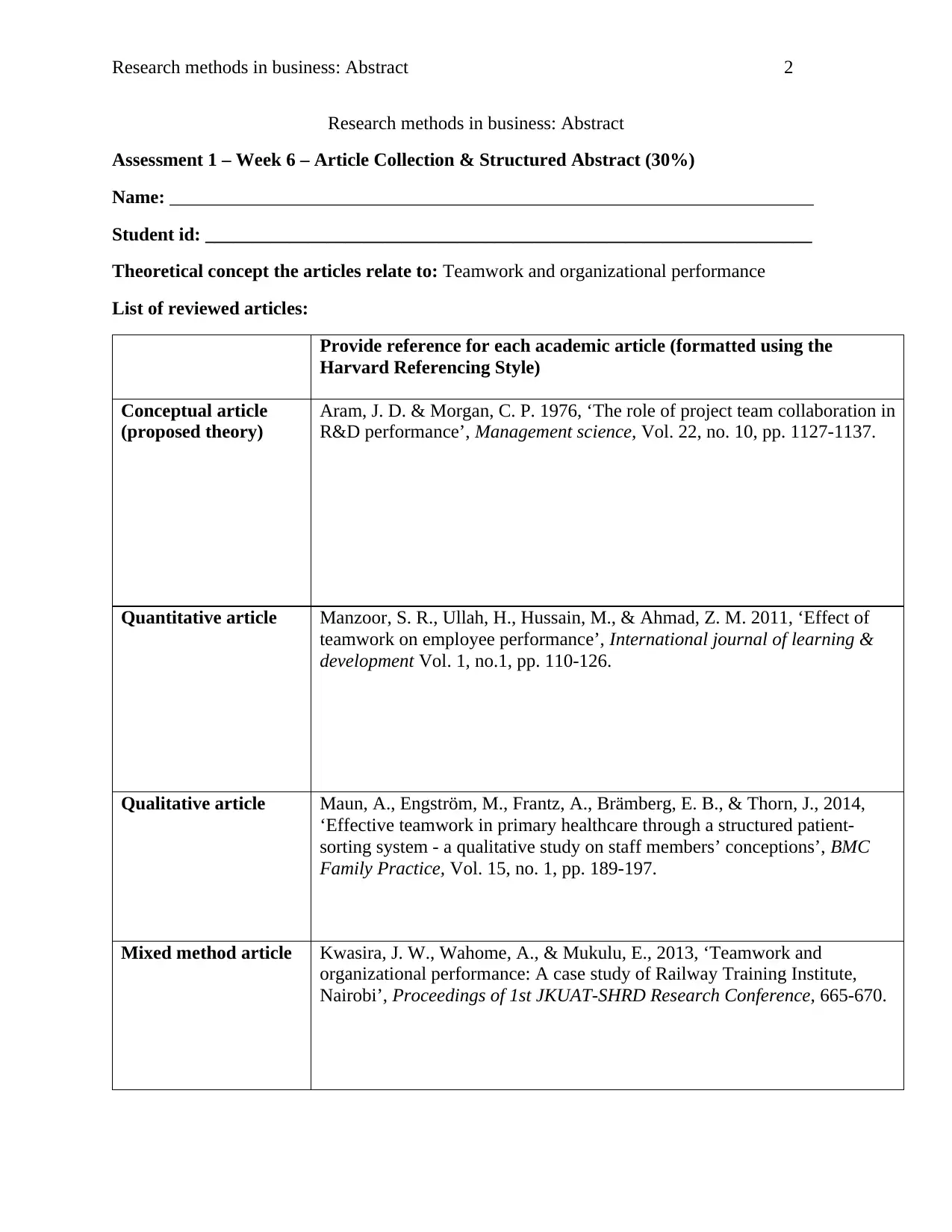
Research methods in business: Abstract 2
Research methods in business: Abstract
Assessment 1 – Week 6 – Article Collection & Structured Abstract (30%)
Name: _____________________________________________________________________
Student id: _________________________________________________________________
Theoretical concept the articles relate to: Teamwork and organizational performance
List of reviewed articles:
Provide reference for each academic article (formatted using the
Harvard Referencing Style)
Conceptual article
(proposed theory)
Aram, J. D. & Morgan, C. P. 1976, ‘The role of project team collaboration in
R&D performance’, Management science, Vol. 22, no. 10, pp. 1127-1137.
Quantitative article Manzoor, S. R., Ullah, H., Hussain, M., & Ahmad, Z. M. 2011, ‘Effect of
teamwork on employee performance’, International journal of learning &
development Vol. 1, no.1, pp. 110-126.
Qualitative article Maun, A., Engström, M., Frantz, A., Brämberg, E. B., & Thorn, J., 2014,
‘Effective teamwork in primary healthcare through a structured patient-
sorting system - a qualitative study on staff members’ conceptions’, BMC
Family Practice, Vol. 15, no. 1, pp. 189-197.
Mixed method article Kwasira, J. W., Wahome, A., & Mukulu, E., 2013, ‘Teamwork and
organizational performance: A case study of Railway Training Institute,
Nairobi’, Proceedings of 1st JKUAT-SHRD Research Conference, 665-670.
Research methods in business: Abstract
Assessment 1 – Week 6 – Article Collection & Structured Abstract (30%)
Name: _____________________________________________________________________
Student id: _________________________________________________________________
Theoretical concept the articles relate to: Teamwork and organizational performance
List of reviewed articles:
Provide reference for each academic article (formatted using the
Harvard Referencing Style)
Conceptual article
(proposed theory)
Aram, J. D. & Morgan, C. P. 1976, ‘The role of project team collaboration in
R&D performance’, Management science, Vol. 22, no. 10, pp. 1127-1137.
Quantitative article Manzoor, S. R., Ullah, H., Hussain, M., & Ahmad, Z. M. 2011, ‘Effect of
teamwork on employee performance’, International journal of learning &
development Vol. 1, no.1, pp. 110-126.
Qualitative article Maun, A., Engström, M., Frantz, A., Brämberg, E. B., & Thorn, J., 2014,
‘Effective teamwork in primary healthcare through a structured patient-
sorting system - a qualitative study on staff members’ conceptions’, BMC
Family Practice, Vol. 15, no. 1, pp. 189-197.
Mixed method article Kwasira, J. W., Wahome, A., & Mukulu, E., 2013, ‘Teamwork and
organizational performance: A case study of Railway Training Institute,
Nairobi’, Proceedings of 1st JKUAT-SHRD Research Conference, 665-670.
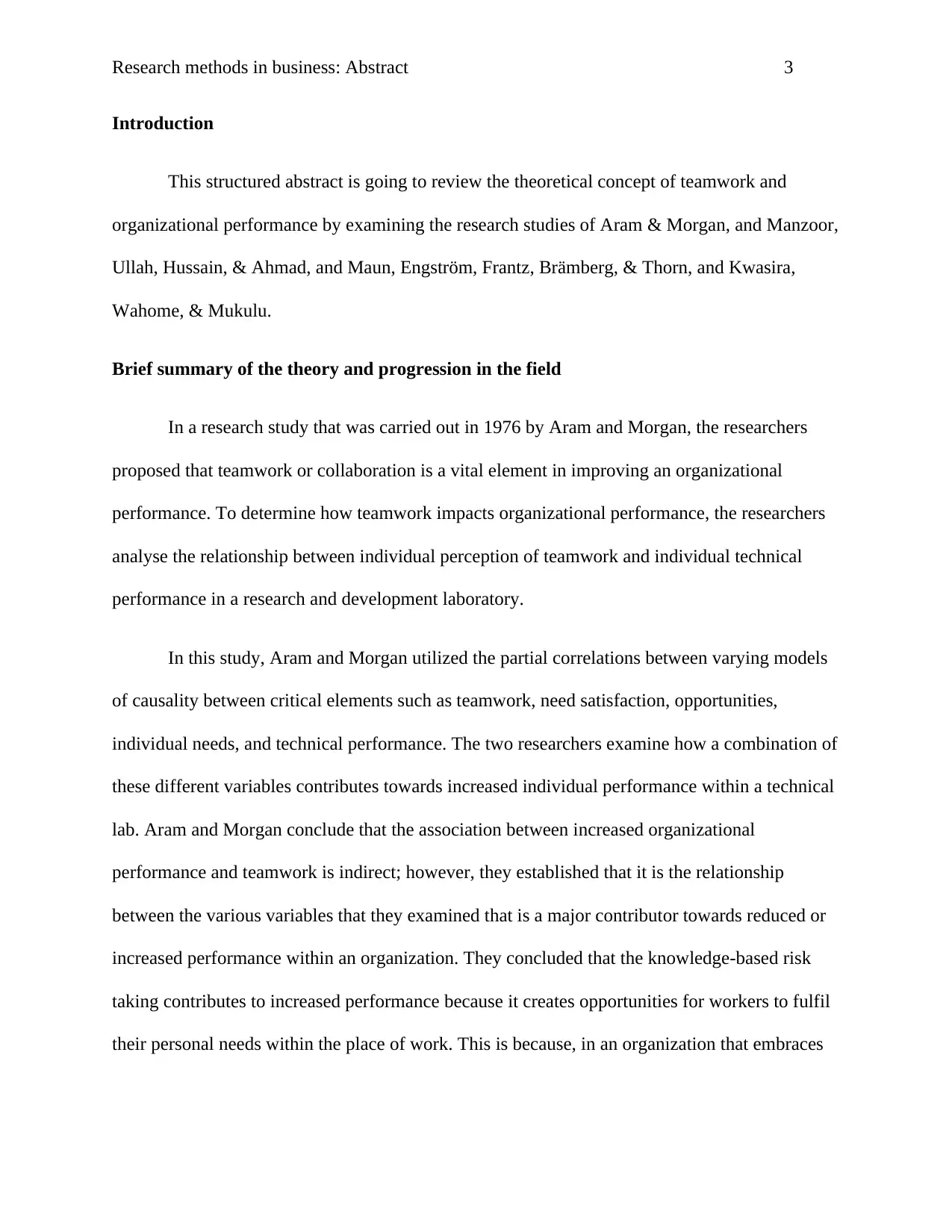
Research methods in business: Abstract 3
Introduction
This structured abstract is going to review the theoretical concept of teamwork and
organizational performance by examining the research studies of Aram & Morgan, and Manzoor,
Ullah, Hussain, & Ahmad, and Maun, Engström, Frantz, Brämberg, & Thorn, and Kwasira,
Wahome, & Mukulu.
Brief summary of the theory and progression in the field
In a research study that was carried out in 1976 by Aram and Morgan, the researchers
proposed that teamwork or collaboration is a vital element in improving an organizational
performance. To determine how teamwork impacts organizational performance, the researchers
analyse the relationship between individual perception of teamwork and individual technical
performance in a research and development laboratory.
In this study, Aram and Morgan utilized the partial correlations between varying models
of causality between critical elements such as teamwork, need satisfaction, opportunities,
individual needs, and technical performance. The two researchers examine how a combination of
these different variables contributes towards increased individual performance within a technical
lab. Aram and Morgan conclude that the association between increased organizational
performance and teamwork is indirect; however, they established that it is the relationship
between the various variables that they examined that is a major contributor towards reduced or
increased performance within an organization. They concluded that the knowledge-based risk
taking contributes to increased performance because it creates opportunities for workers to fulfil
their personal needs within the place of work. This is because, in an organization that embraces
Introduction
This structured abstract is going to review the theoretical concept of teamwork and
organizational performance by examining the research studies of Aram & Morgan, and Manzoor,
Ullah, Hussain, & Ahmad, and Maun, Engström, Frantz, Brämberg, & Thorn, and Kwasira,
Wahome, & Mukulu.
Brief summary of the theory and progression in the field
In a research study that was carried out in 1976 by Aram and Morgan, the researchers
proposed that teamwork or collaboration is a vital element in improving an organizational
performance. To determine how teamwork impacts organizational performance, the researchers
analyse the relationship between individual perception of teamwork and individual technical
performance in a research and development laboratory.
In this study, Aram and Morgan utilized the partial correlations between varying models
of causality between critical elements such as teamwork, need satisfaction, opportunities,
individual needs, and technical performance. The two researchers examine how a combination of
these different variables contributes towards increased individual performance within a technical
lab. Aram and Morgan conclude that the association between increased organizational
performance and teamwork is indirect; however, they established that it is the relationship
between the various variables that they examined that is a major contributor towards reduced or
increased performance within an organization. They concluded that the knowledge-based risk
taking contributes to increased performance because it creates opportunities for workers to fulfil
their personal needs within the place of work. This is because, in an organization that embraces
⊘ This is a preview!⊘
Do you want full access?
Subscribe today to unlock all pages.

Trusted by 1+ million students worldwide
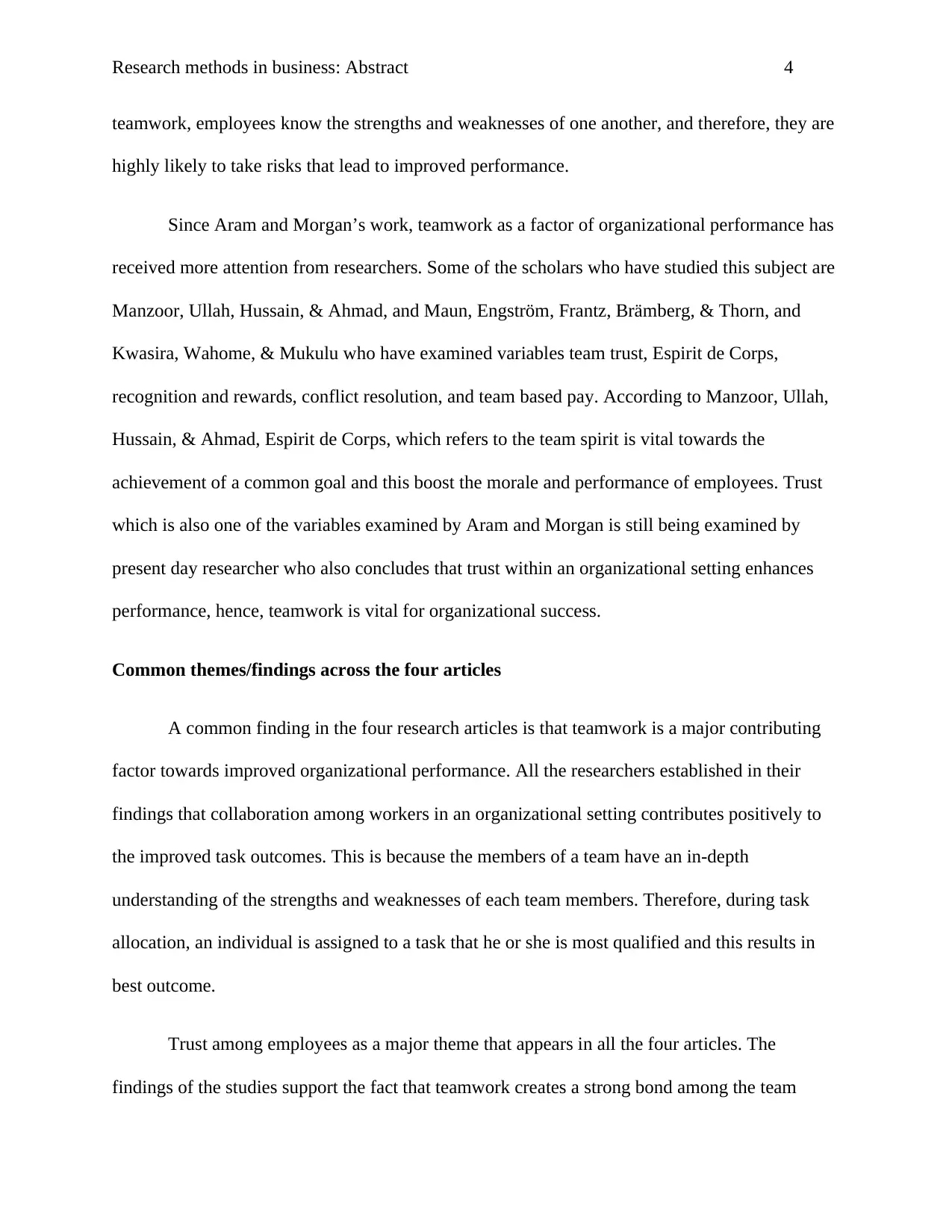
Research methods in business: Abstract 4
teamwork, employees know the strengths and weaknesses of one another, and therefore, they are
highly likely to take risks that lead to improved performance.
Since Aram and Morgan’s work, teamwork as a factor of organizational performance has
received more attention from researchers. Some of the scholars who have studied this subject are
Manzoor, Ullah, Hussain, & Ahmad, and Maun, Engström, Frantz, Brämberg, & Thorn, and
Kwasira, Wahome, & Mukulu who have examined variables team trust, Espirit de Corps,
recognition and rewards, conflict resolution, and team based pay. According to Manzoor, Ullah,
Hussain, & Ahmad, Espirit de Corps, which refers to the team spirit is vital towards the
achievement of a common goal and this boost the morale and performance of employees. Trust
which is also one of the variables examined by Aram and Morgan is still being examined by
present day researcher who also concludes that trust within an organizational setting enhances
performance, hence, teamwork is vital for organizational success.
Common themes/findings across the four articles
A common finding in the four research articles is that teamwork is a major contributing
factor towards improved organizational performance. All the researchers established in their
findings that collaboration among workers in an organizational setting contributes positively to
the improved task outcomes. This is because the members of a team have an in-depth
understanding of the strengths and weaknesses of each team members. Therefore, during task
allocation, an individual is assigned to a task that he or she is most qualified and this results in
best outcome.
Trust among employees as a major theme that appears in all the four articles. The
findings of the studies support the fact that teamwork creates a strong bond among the team
teamwork, employees know the strengths and weaknesses of one another, and therefore, they are
highly likely to take risks that lead to improved performance.
Since Aram and Morgan’s work, teamwork as a factor of organizational performance has
received more attention from researchers. Some of the scholars who have studied this subject are
Manzoor, Ullah, Hussain, & Ahmad, and Maun, Engström, Frantz, Brämberg, & Thorn, and
Kwasira, Wahome, & Mukulu who have examined variables team trust, Espirit de Corps,
recognition and rewards, conflict resolution, and team based pay. According to Manzoor, Ullah,
Hussain, & Ahmad, Espirit de Corps, which refers to the team spirit is vital towards the
achievement of a common goal and this boost the morale and performance of employees. Trust
which is also one of the variables examined by Aram and Morgan is still being examined by
present day researcher who also concludes that trust within an organizational setting enhances
performance, hence, teamwork is vital for organizational success.
Common themes/findings across the four articles
A common finding in the four research articles is that teamwork is a major contributing
factor towards improved organizational performance. All the researchers established in their
findings that collaboration among workers in an organizational setting contributes positively to
the improved task outcomes. This is because the members of a team have an in-depth
understanding of the strengths and weaknesses of each team members. Therefore, during task
allocation, an individual is assigned to a task that he or she is most qualified and this results in
best outcome.
Trust among employees as a major theme that appears in all the four articles. The
findings of the studies support the fact that teamwork creates a strong bond among the team
Paraphrase This Document
Need a fresh take? Get an instant paraphrase of this document with our AI Paraphraser
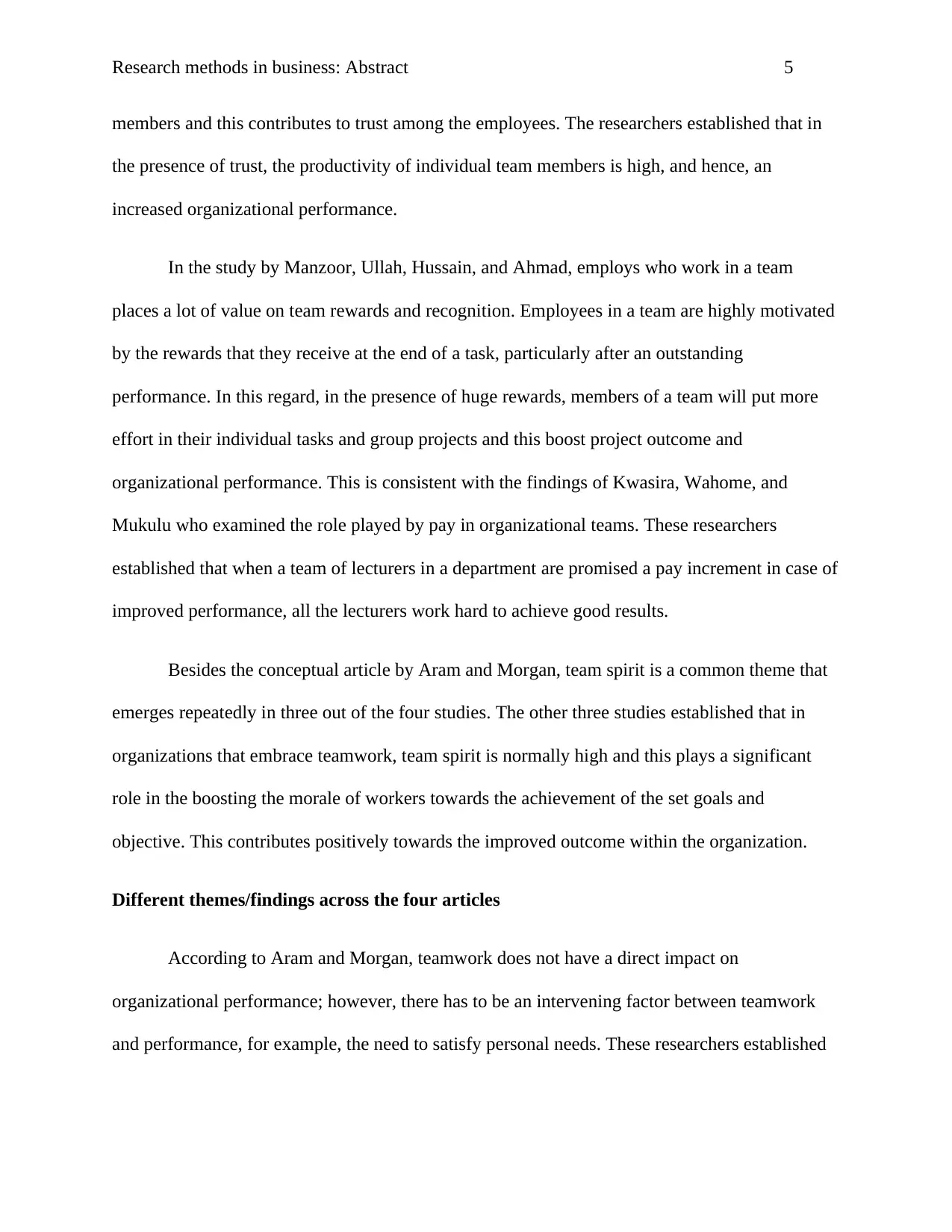
Research methods in business: Abstract 5
members and this contributes to trust among the employees. The researchers established that in
the presence of trust, the productivity of individual team members is high, and hence, an
increased organizational performance.
In the study by Manzoor, Ullah, Hussain, and Ahmad, employs who work in a team
places a lot of value on team rewards and recognition. Employees in a team are highly motivated
by the rewards that they receive at the end of a task, particularly after an outstanding
performance. In this regard, in the presence of huge rewards, members of a team will put more
effort in their individual tasks and group projects and this boost project outcome and
organizational performance. This is consistent with the findings of Kwasira, Wahome, and
Mukulu who examined the role played by pay in organizational teams. These researchers
established that when a team of lecturers in a department are promised a pay increment in case of
improved performance, all the lecturers work hard to achieve good results.
Besides the conceptual article by Aram and Morgan, team spirit is a common theme that
emerges repeatedly in three out of the four studies. The other three studies established that in
organizations that embrace teamwork, team spirit is normally high and this plays a significant
role in the boosting the morale of workers towards the achievement of the set goals and
objective. This contributes positively towards the improved outcome within the organization.
Different themes/findings across the four articles
According to Aram and Morgan, teamwork does not have a direct impact on
organizational performance; however, there has to be an intervening factor between teamwork
and performance, for example, the need to satisfy personal needs. These researchers established
members and this contributes to trust among the employees. The researchers established that in
the presence of trust, the productivity of individual team members is high, and hence, an
increased organizational performance.
In the study by Manzoor, Ullah, Hussain, and Ahmad, employs who work in a team
places a lot of value on team rewards and recognition. Employees in a team are highly motivated
by the rewards that they receive at the end of a task, particularly after an outstanding
performance. In this regard, in the presence of huge rewards, members of a team will put more
effort in their individual tasks and group projects and this boost project outcome and
organizational performance. This is consistent with the findings of Kwasira, Wahome, and
Mukulu who examined the role played by pay in organizational teams. These researchers
established that when a team of lecturers in a department are promised a pay increment in case of
improved performance, all the lecturers work hard to achieve good results.
Besides the conceptual article by Aram and Morgan, team spirit is a common theme that
emerges repeatedly in three out of the four studies. The other three studies established that in
organizations that embrace teamwork, team spirit is normally high and this plays a significant
role in the boosting the morale of workers towards the achievement of the set goals and
objective. This contributes positively towards the improved outcome within the organization.
Different themes/findings across the four articles
According to Aram and Morgan, teamwork does not have a direct impact on
organizational performance; however, there has to be an intervening factor between teamwork
and performance, for example, the need to satisfy personal needs. These researchers established
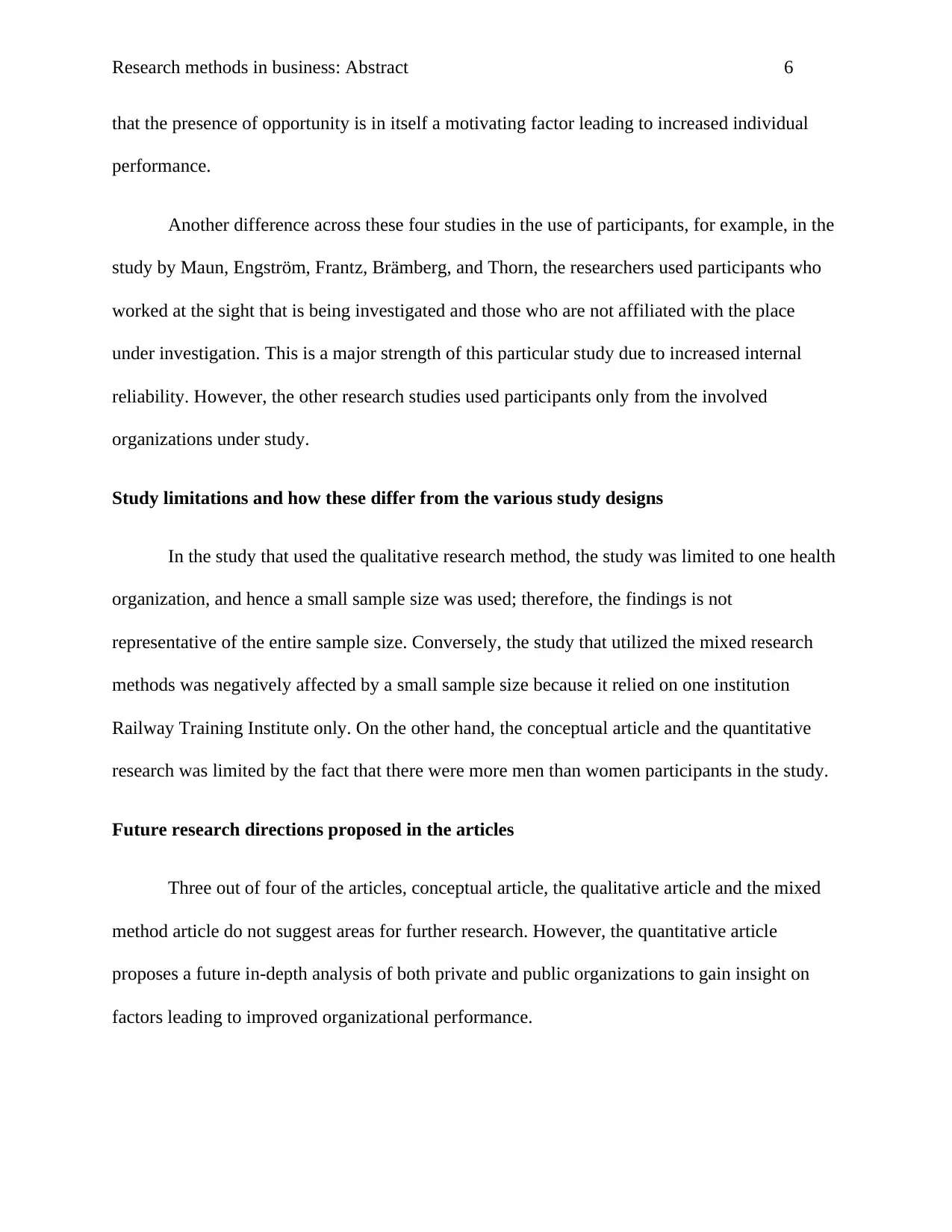
Research methods in business: Abstract 6
that the presence of opportunity is in itself a motivating factor leading to increased individual
performance.
Another difference across these four studies in the use of participants, for example, in the
study by Maun, Engström, Frantz, Brämberg, and Thorn, the researchers used participants who
worked at the sight that is being investigated and those who are not affiliated with the place
under investigation. This is a major strength of this particular study due to increased internal
reliability. However, the other research studies used participants only from the involved
organizations under study.
Study limitations and how these differ from the various study designs
In the study that used the qualitative research method, the study was limited to one health
organization, and hence a small sample size was used; therefore, the findings is not
representative of the entire sample size. Conversely, the study that utilized the mixed research
methods was negatively affected by a small sample size because it relied on one institution
Railway Training Institute only. On the other hand, the conceptual article and the quantitative
research was limited by the fact that there were more men than women participants in the study.
Future research directions proposed in the articles
Three out of four of the articles, conceptual article, the qualitative article and the mixed
method article do not suggest areas for further research. However, the quantitative article
proposes a future in-depth analysis of both private and public organizations to gain insight on
factors leading to improved organizational performance.
that the presence of opportunity is in itself a motivating factor leading to increased individual
performance.
Another difference across these four studies in the use of participants, for example, in the
study by Maun, Engström, Frantz, Brämberg, and Thorn, the researchers used participants who
worked at the sight that is being investigated and those who are not affiliated with the place
under investigation. This is a major strength of this particular study due to increased internal
reliability. However, the other research studies used participants only from the involved
organizations under study.
Study limitations and how these differ from the various study designs
In the study that used the qualitative research method, the study was limited to one health
organization, and hence a small sample size was used; therefore, the findings is not
representative of the entire sample size. Conversely, the study that utilized the mixed research
methods was negatively affected by a small sample size because it relied on one institution
Railway Training Institute only. On the other hand, the conceptual article and the quantitative
research was limited by the fact that there were more men than women participants in the study.
Future research directions proposed in the articles
Three out of four of the articles, conceptual article, the qualitative article and the mixed
method article do not suggest areas for further research. However, the quantitative article
proposes a future in-depth analysis of both private and public organizations to gain insight on
factors leading to improved organizational performance.
⊘ This is a preview!⊘
Do you want full access?
Subscribe today to unlock all pages.

Trusted by 1+ million students worldwide
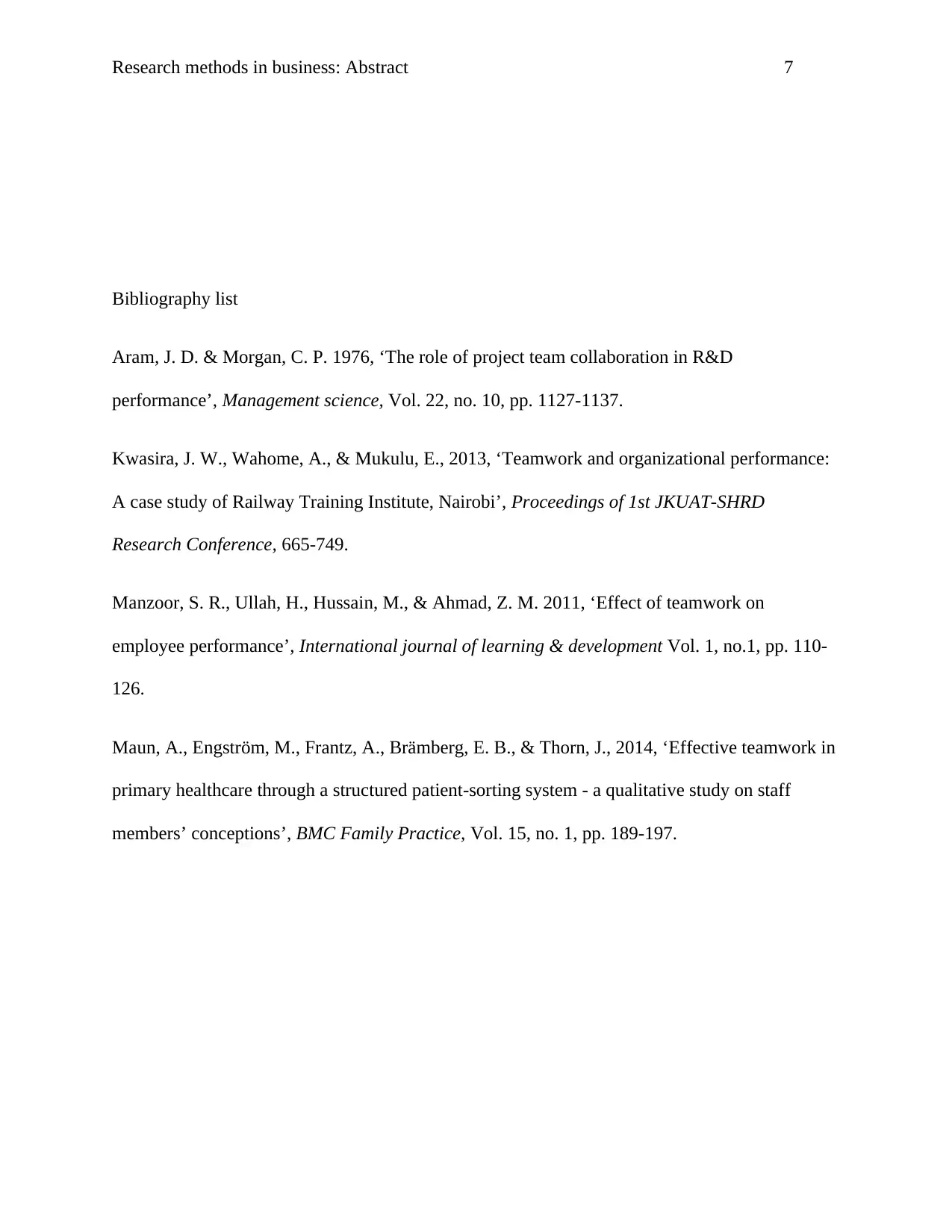
Research methods in business: Abstract 7
Bibliography list
Aram, J. D. & Morgan, C. P. 1976, ‘The role of project team collaboration in R&D
performance’, Management science, Vol. 22, no. 10, pp. 1127-1137.
Kwasira, J. W., Wahome, A., & Mukulu, E., 2013, ‘Teamwork and organizational performance:
A case study of Railway Training Institute, Nairobi’, Proceedings of 1st JKUAT-SHRD
Research Conference, 665-749.
Manzoor, S. R., Ullah, H., Hussain, M., & Ahmad, Z. M. 2011, ‘Effect of teamwork on
employee performance’, International journal of learning & development Vol. 1, no.1, pp. 110-
126.
Maun, A., Engström, M., Frantz, A., Brämberg, E. B., & Thorn, J., 2014, ‘Effective teamwork in
primary healthcare through a structured patient-sorting system - a qualitative study on staff
members’ conceptions’, BMC Family Practice, Vol. 15, no. 1, pp. 189-197.
Bibliography list
Aram, J. D. & Morgan, C. P. 1976, ‘The role of project team collaboration in R&D
performance’, Management science, Vol. 22, no. 10, pp. 1127-1137.
Kwasira, J. W., Wahome, A., & Mukulu, E., 2013, ‘Teamwork and organizational performance:
A case study of Railway Training Institute, Nairobi’, Proceedings of 1st JKUAT-SHRD
Research Conference, 665-749.
Manzoor, S. R., Ullah, H., Hussain, M., & Ahmad, Z. M. 2011, ‘Effect of teamwork on
employee performance’, International journal of learning & development Vol. 1, no.1, pp. 110-
126.
Maun, A., Engström, M., Frantz, A., Brämberg, E. B., & Thorn, J., 2014, ‘Effective teamwork in
primary healthcare through a structured patient-sorting system - a qualitative study on staff
members’ conceptions’, BMC Family Practice, Vol. 15, no. 1, pp. 189-197.
1 out of 7
Your All-in-One AI-Powered Toolkit for Academic Success.
+13062052269
info@desklib.com
Available 24*7 on WhatsApp / Email
![[object Object]](/_next/static/media/star-bottom.7253800d.svg)
Unlock your academic potential
Copyright © 2020–2025 A2Z Services. All Rights Reserved. Developed and managed by ZUCOL.